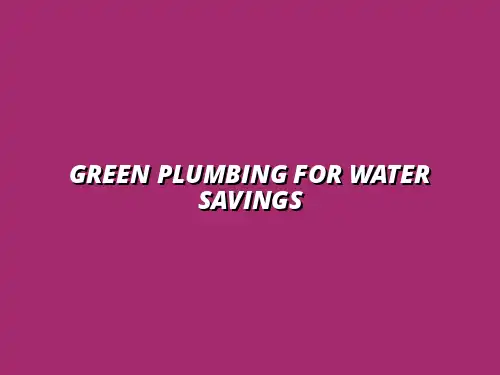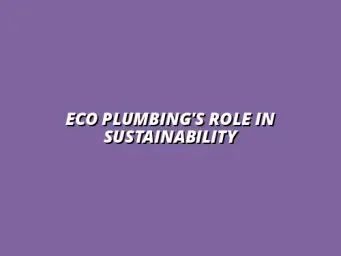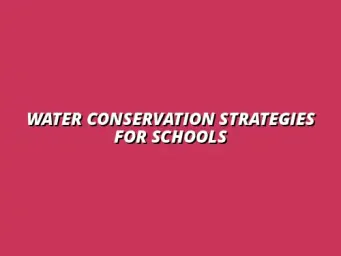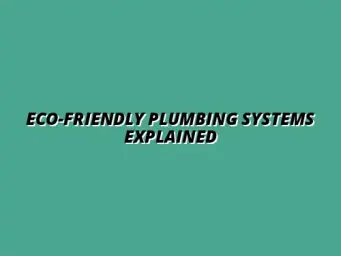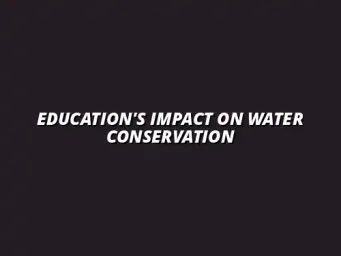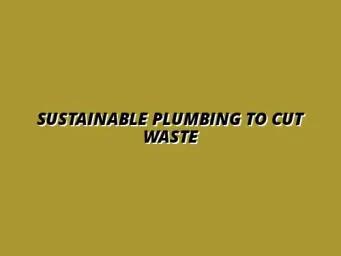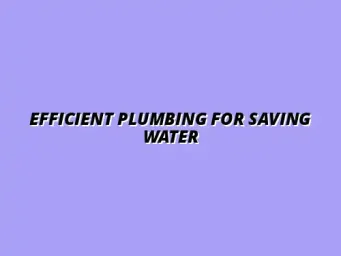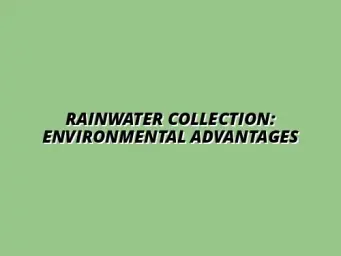The Role of Green Plumbing in Sustainable Water Management
Green plumbing plays an essential role in our efforts to manage water sustainably. As the global population grows, the demand for water increases, making it crucial to adopt practices that conserve this precious resource. By understanding and implementing green plumbing practices, we can significantly reduce our water consumption and protect the environment.
This article will explore the various aspects of green plumbing, from its definition and components to its impact on water conservation and the innovative technologies that support it. By the end, you will see how these practices not only benefit the environment but also lead to financial savings for homeowners. Learn more about eco-friendly plumbing benefits for homeowners and how they can positively impact your life.
Understanding Green Plumbing Practices
Green plumbing refers to the adoption of plumbing systems and practices that are designed to minimize water usage and reduce waste. This approach prioritizes environmentally friendly techniques and technologies that contribute to sustainable water management. By embracing green plumbing, individuals and communities can lower their ecological footprint and promote a healthier planet.
Some key principles of green plumbing include:
- Efficiency: Using fixtures and appliances that consume less water.
- Recycling: Implementing systems for greywater recycling and rainwater harvesting.
- Durability: Choosing long-lasting materials that require less maintenance.
Defining Green Plumbing and Its Importance
Defining green plumbing is essential to understanding its significance in water management. Essentially, it focuses on using plumbing materials and systems that have minimal environmental impact. This is important because water scarcity is becoming a pressing issue worldwide, and every drop counts!
By adopting green plumbing practices, we can:
- Conserve water resources for future generations.
- Reduce energy consumption related to water heating. For tips on water heater maintenance, click here.
- Promote public awareness about sustainable practices.
Key Components of Green Plumbing Systems
Green plumbing systems consist of several key components that work together to minimize water usage. These components include:
- Low-flow fixtures: These fixtures help to reduce water flow while maintaining performance.
- Greywater systems: These systems recycle water from sinks and showers for irrigation.
- Rainwater harvesting: Collecting rainwater for household use reduces reliance on municipal water supplies.
By integrating these elements, green plumbing systems become more efficient and effective at conserving water.
The Connection Between Green Plumbing and Water Conservation
There is a strong connection between green plumbing practices and water conservation. Essentially, green plumbing aims to reduce water waste and promote the responsible use of resources. This connection ultimately leads to healthier ecosystems and more sustainable communities.
Implementing green plumbing strategies can yield significant water savings. For instance, adopting low-flow fixtures can help reduce household water usage by as much as 30%, making a noticeable impact on both the environment and our utility bills! Check out these water saving tips for your home to learn more.
How Green Plumbing Reduces Water Waste
Green plumbing focuses on minimizing water waste through various methods. By using efficient fixtures and appliances, households can conserve water without sacrificing comfort or usability. Preventing clogged drains is also crucial for efficient water management. Here are some key tips for preventing clogged drains.
- Installing flow-restricting showerheads and faucets.
- Utilizing dual-flush toilets that use less water for liquid waste.
- Implementing rainwater collection systems for irrigation.
These practices collectively lead to a decrease in overall water consumption and contribute to a more sustainable future.
Impact on Household Water Usage
The impact of green plumbing on household water usage can be quite remarkable. Many homeowners report a significant reduction in their monthly water bills after implementing green plumbing solutions. This is not only beneficial for the wallet but also for the environment.
Families can expect to see a decrease in water usage through:
- The addition of energy-efficient appliances.
- Regular maintenance checks on plumbing systems to prevent leaks.
- Conducting water audits to identify wasteful practices. Learn how to reduce water waste with daily tips.
These changes encourage a more mindful approach to water consumption and help preserve this essential resource.
Innovative Technologies in Green Plumbing
Innovative technologies play a crucial role in the effectiveness of green plumbing. With the advancement of new materials and systems, it's easier than ever to incorporate eco-friendly solutions into our homes. These technologies not only save water but also enhance the overall performance of plumbing systems.
Some exciting developments in green plumbing include:
- Smart faucets that adjust flow rates based on usage.
- Water-saving irrigation systems that optimize water delivery.
- Advanced leak detection technology that alerts homeowners to issues.
Water-Efficient Fixtures and Appliances
Water-efficient fixtures and appliances are at the forefront of green plumbing technologies. These innovations are designed to use less water while still providing high performance. Homeowners can choose from a variety of options, including:
- Low-flow showerheads: Reduce water flow without sacrificing pressure.
- High-efficiency toilets: Use significantly less water per flush.
- Dishwashers and washing machines: Designed to consume less water than traditional models.
Integrating these fixtures into your home can lead to substantial water savings.
Rainwater Harvesting Systems
Rainwater harvesting systems are an innovative solution for sustainable water management. These systems collect and store rainwater for later use, reducing reliance on municipal water supplies. This method not only conserves water but also helps manage stormwater runoff.
Key components of rainwater harvesting systems include:
- Collection surfaces, such as roofs.
- Storage tanks to hold the harvested rainwater.
- Filtration systems to ensure clean water for use.
Implementing rainwater harvesting can make a significant impact on overall water usage in households and communities.
Greywater Recycling: A Practical Approach
Greywater recycling is another excellent avenue for conserving water in homes. This system involves reusing wastewater from sinks, showers, and washing machines for irrigation or toilet flushing. By diverting greywater from the sewage system, we can significantly reduce our water footprint.
Some benefits of greywater recycling systems include:
- Lower water bills due to reduced need for municipal water.
- Decreased pressure on sewage systems and treatment facilities.
- Enhanced landscape irrigation and plant health.
This practical approach helps to ensure that water is used wisely and efficiently in our everyday lives.
Benefits of Implementing Green Plumbing Solutions
Implementing green plumbing solutions offers numerous benefits for homeowners and the environment alike. These advantages range from financial savings to contributing to a healthier planet. It's not just about saving water—it's about improving our quality of life!
Some of the benefits of green plumbing include:
- Lower utility bills as a result of reduced water consumption.
- Increased home value due to the installation of modern, efficient fixtures.
- Positive environmental impact through conservation efforts.
Long-term Financial Savings for Homeowners
Long-term financial savings are one of the most appealing aspects of adopting green plumbing solutions. By reducing water waste, homeowners can see a substantial decrease in their monthly utility bills. This results not only from using water-efficient fixtures but also from less energy consumption associated with heating water. Winter plumbing can be a challenge; avoid freezing pipes with these winter plumbing tips.
Many homeowners find that, over time, these savings can add up to significant amounts. Some ways to maximize financial savings include:
- Regular maintenance of plumbing systems to prevent leaks.
- Taking advantage of local rebates for energy-efficient upgrades.
- Investing in quality plumbing fixtures that last longer.
Making these changes can lead to a more sustainable lifestyle while benefiting your wallet!
Environmental Benefits: Reducing Overall Water Consumption
The environmental benefits of green plumbing are far-reaching. By conserving water, we can help protect our ecosystems and ensure that future generations have access to this vital resource. Reducing overall water consumption leads to healthier landscapes and less strain on water treatment facilities.
Some important environmental impacts include:
- Improved water quality in local rivers and lakes.
- Preservation of natural habitats for wildlife.
- Reduced energy consumption associated with water heating and treatment.
Overall, embracing green plumbing is a critical step in safeguarding our environment.
Common Misconceptions About Green Plumbing
Despite the clear benefits of green plumbing, there are some common misconceptions that can deter people from making the switch. Addressing these misconceptions is essential to promote understanding and awareness of green plumbing practices. For expert help in Birmingham, consider a plumber in Great Barr, Birmingham.
Many people believe that green plumbing is too expensive or complicated to implement. In reality, these systems can be quite affordable and straightforward with the right guidance!
Addressing Cost Concerns
Cost concerns often arise when discussing green plumbing solutions. However, many affordable options exist that can significantly reduce upfront investment while providing long-term savings. In fact, energy-efficient fixtures often pay for themselves over time through reduced utility bills.
Moreover, there are numerous incentives available, such as:
- Government rebates for energy-efficient home upgrades.
- Tax credits for installing certain green plumbing systems.
- Local programs promoting sustainable practices.
By exploring these options, homeowners can find green plumbing solutions that fit their budget.
Debunking Myths About Effectiveness
Another common myth is that green plumbing solutions are less effective than traditional plumbing systems. This could not be further from the truth! Many green plumbing technologies, such as low-flow fixtures, are designed to deliver exceptional performance while using significantly less water.
In fact, studies show that households using green plumbing often experience:
- Improved water pressure with low-flow fixtures.
- Enhanced comfort and usability with modern systems.
- Greater satisfaction with overall plumbing performance.
By debunking these myths, we can encourage more people to embrace green plumbing and contribute to a sustainable water future.
Practical Steps for Adopting Green Plumbing Practices
Transitioning to green plumbing practices can seem overwhelming, but it doesn't have to be! By following practical steps, you can make this change easier and more manageable. The first step is to evaluate your current plumbing system.
Understanding your own plumbing is crucial. This means taking a close look at the fixtures and appliances you currently have and assessing their efficiency.
Evaluating Your Current Plumbing System
To begin, you should focus on identifying water-wasting fixtures. These can be anything from leaky faucets to inefficient toilets that use too much water. By spotting these issues, you can create a plan to replace or repair them.
Here are some common water-wasting fixtures you might find:
- Leaky faucets
- Old toilets that use excessive water per flush
- Showerheads that don't meet efficiency standards
Next, it’s important to assess your water consumption patterns. Track your monthly water bill and understand how much water your household uses. This will help you determine where you can make changes.
Identifying Water-Wasting Fixtures
Once you've assessed your plumbing system, make a list of fixtures that could be wasting water. You can then prioritize which ones to replace first based on their impact on your overall water usage.
Consider these factors:
- Age of the fixture
- Type and model efficiency ratings
- Presence of leaks or malfunctions
Next, look for modern upgrades that are both efficient and affordable!
Assessing Your Water Consumption Patterns
Tracking your water usage over time will give you a clearer picture of your consumption habits. You can do this with a simple log or by using smart water meters that provide detailed insights.
To effectively assess your water consumption, consider:
- Monthly water bills
- Number of people in your household
- Watering schedules for lawns or gardens
This information will help you set realistic targets for reducing water usage.
Choosing the Right Green Plumbing Solutions
After evaluating your system, it's time to choose the right green plumbing solutions. This can involve selecting water-efficient fixtures and appliances that align with your sustainability goals. Making informed choices will lead to better water conservation.
Here are some options to consider when upgrading your fixtures:
- Low-flow showerheads
- Dual-flush toilets
- Water-efficient washing machines
Selecting Water-Efficient Fixtures and Appliances
When selecting fixtures, always look for products with the WaterSense label. These products meet strict efficiency criteria, helping you save both water and money.
In addition to fixtures, consider the following appliances:
- Dishwashers with high-efficiency ratings
- Smart irrigation systems for gardens
- Tankless water heaters
By investing in these appliances, you're contributing to water conservation while lowering your utility bills.
Consulting with Certified Green Plumbers
Working with certified green plumbers can help ensure that your upgrades are not just effective but also properly installed. These professionals can provide valuable insights and recommend the best practices tailored to your needs.
Here are some reasons to consult with them:
- Expertise in green plumbing technologies
- Access to high-quality materials
- Knowledge of local regulations and incentives
Choosing the right professionals can make your transition smoother!
Addressing FAQs About Green Plumbing and Water Conservation
As you explore green plumbing options, you might have some questions. Let’s address a few common FAQs to clear up confusion and provide clarity on this important topic!
What are the Most Effective Green Plumbing Solutions?
The most effective solutions typically include:
- Low-flow fixtures and appliances
- Rainwater harvesting systems
- Greywater recycling systems
These options can significantly reduce your water consumption while promoting sustainability.
How Much Water Can Be Conserved with Green Plumbing?
On average, households can save up to 20% on water usage by adopting green plumbing practices. This translates to hundreds of gallons saved annually! By making simple changes, you can do your part in conserving our precious water resources.
Are There Incentives for Switching to Green Plumbing?
Many areas offer incentives for upgrading to green plumbing. These can include:
- Tax credits
- Rebates for water-efficient fixtures
- Low-interest loans for home improvements
Research local programs and take advantage of these opportunities to offset costs!
Conclusion and Future Perspectives on Water Conservation
As we look towards the future, the role of policy and community is crucial in promoting green plumbing practices. Governments and organizations can create incentive programs that encourage sustainable choices.
Communities can also play a part by sharing resources and knowledge about water conservation practices. We can all work together to make a difference!
The Role of Policy and Community in Promoting Green Plumbing
Policies that support green plumbing can lead to widespread adoption. Community programs that educate homeowners about the benefits of water conservation can also help raise awareness.
By fostering collaboration, we can build a more sustainable future for all!
Encouraging Sustainable Practices in Everyday Life
To wrap it up, implementing green plumbing is not just a personal initiative but a community effort. Encourage friends and family to adopt sustainable practices as well, creating a ripple effect of positive change!
Every small step counts, and together, we can conserve water and protect our environment for generations to come!

